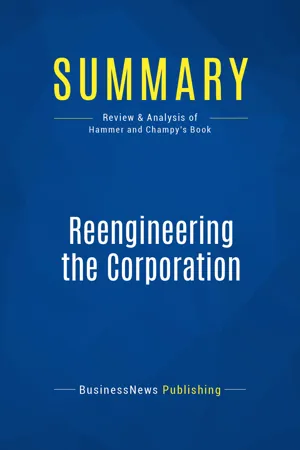
Summary: Reengineering the Corporation
Review and Analysis of Hammer and Champy's Book
- English
- ePUB (mobile friendly)
- Available on iOS & Android
Summary: Reengineering the Corporation
Review and Analysis of Hammer and Champy's Book
About this book
The must-read summary of Michael Hammer and James Champy’s book: “Reengineering the Corporation: A Manifesto for Business Revolution”.
This complete summary of the ideas from Michael Hammer and James Champ’s book “Reengineering the Corporation” shows how it is important to forget about business traditions and invent a new, process-focused business organisation that leads to better performance. In their book, the authors explain how you can use your knowledge to develop a new organisation that is as optimal as possible. By re-engineering the rules of business, you will be able to gain a true competitive advantage.
Added-value of this summary:
• Save time
• Understand the key concepts
• Expand your business knowledge
To learn more, read “Reengineering the Corporation: A Manifesto for Business Revolution” to prepare your business for the future and achieve success.
Frequently asked questions
- Essential is ideal for learners and professionals who enjoy exploring a wide range of subjects. Access the Essential Library with 800,000+ trusted titles and best-sellers across business, personal growth, and the humanities. Includes unlimited reading time and Standard Read Aloud voice.
- Complete: Perfect for advanced learners and researchers needing full, unrestricted access. Unlock 1.4M+ books across hundreds of subjects, including academic and specialized titles. The Complete Plan also includes advanced features like Premium Read Aloud and Research Assistant.
Please note we cannot support devices running on iOS 13 and Android 7 or earlier. Learn more about using the app.
Information
Summary of Reengineering the Corporation (Michael Hammer & James Champy)
Section 1 : The Reengineering Concept

- Are fast
- Deliver high quality consistently.
- Are flexible.
- Are low cost.
- Stage 1 – 1776 Adam Smith published The Wealth of Nations. In this, he suggested the specialization of labor as a way for workers to achieve greater productivity. Smith’s ideas suggested efficiency could best be achieved by breaking large jobs down into small tasks which could be performed repetitively.
- Stage 2 – 1820s The railroad companies introduced bureaucracies to avoid collisions on single-track lines – formal operating procedures, centralized management and a rule for every contingency. This was the forerunner of the command-and-control system still in use today – where there are workers and supervisors to keep things organized.
- Stage 3 – Early 1900s Henry Ford introduced the assembly line – workers performed one tiny step in a complex process where the work is brought to the worker rather than the other way around– while Alfred Sloan created small, decentralized management teams for GM so that huge, sprawling operations could be managed efficiently.
- Stage 4 – The 1945 – 1960 Era The hierarchical or pyramid organizational structure became popular as the best way to match production capacity and demand for mass produced consumer goods. Functional middle managers were added to provide control and management.
- Delay and errors.
- Rigidity.
- High overhead costs.
- A focus on fundamentals. Addressing the issue of precisely what it is the corporation does, why is it done the present way and what are the tacit rules and assumptions embedded in present practices. Reengineering ignores “what is” and concentrates on “what should be”.
- A radical redesign element. Reengineering is about reinventing the business – not making superficial changes or marginal enhancements to the old ways of doing things.
- The potential for dramatic results. Reengineering leads to quantum leaps in performance – not incremental improvements.
- A business process orientation. Reengineering evolves around business processes – not tasks, job descriptions, people or structures. A business process takes an input or inputs and generates an output which is of value to the customer. A business process only works if it generates added value, not internal activity.
- Companies that find themselves in deep competitive trouble – and who often require an order of magnitude improvement somewhere in their operations to be able to compete with others in their field.
- Companies with managers who can see problems arising a little further down the road they are traveling on – and who want to begin reengineering before all competitive advantages they possess evaporate.
- Companies with managers who are ambitious and aggressive – who see reengineering as a way to position the company to extend their lead over their competitors.
- Should not be confused with automation – since doing the wrong things more efficiently will make few, if any, improvements to a bu...
Table of contents
- Title page
- Book Presentation
- Summary of Reengineering the Corporation (Michael Hammer & James Champy)
- About the Summary Publisher
- Copyright